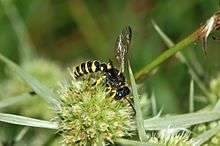Philanthinae
| Philanthinae | |
|---|---|
 | |
| Cerceris | |
| Scientific classification | |
| Kingdom: | Animalia |
| Phylum: | Arthropoda |
| Class: | Insecta |
| Order: | Hymenoptera |
| Family: | Crabronidae |
| Subfamily: | Philanthinae |
| Tribes and Genera | |
|
Aphilanthopini:
Cercerini:
Philanthini:
Pseudoscoliini:
| |
The subfamilly Philanthinae is one of the largest groups in the wasp family Crabronidae, even though it contains only 9 genera; Alexander treats it as having only 8 genera.[1] Historically, this subfamily has frequently been accorded family status. The subfamily consists of solitary, predatory wasps, each genus having its own distinct and consistent prey preferences. The adult females dig tunnels in the ground for nesting.
As with all other sphecoid wasps, the larvae are carnivorous; females hunt for prey on which to lays their eggs, mass provisioning the nest cells with paralyzed, living prey that the larva feeds upon after it hatches from the egg, as seen in the species Philanthus gibbosus.[2]
References
- ↑ Alexander, B. A. (1992). A cladistic analysis of the subfamily Philanthinae (Hymenoptera: Sphecidae). Systematic Entomology 17: 91–108. doi: 10.1111/j.1365-3113.1992.tb00324.x
- ↑ Colman, D. R.; Toolson, E. C.; Takacs-Vesbach, C. D. (2012-10-01). "Do diet and taxonomy influence insect gut bacterial communities?". Molecular Ecology. 21 (20): 5124–5137. doi:10.1111/j.1365-294X.2012.05752.x. ISSN 1365-294X.
External links
- BWARS: Philanthinae (photographs of each species)